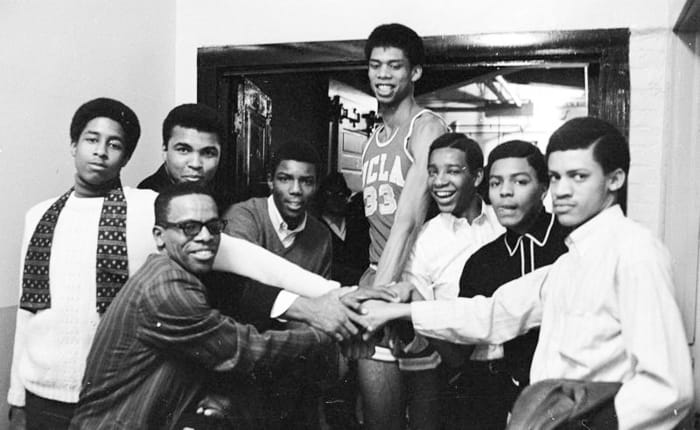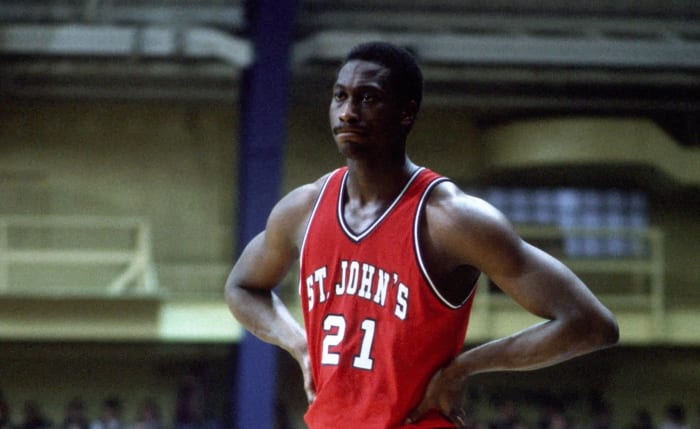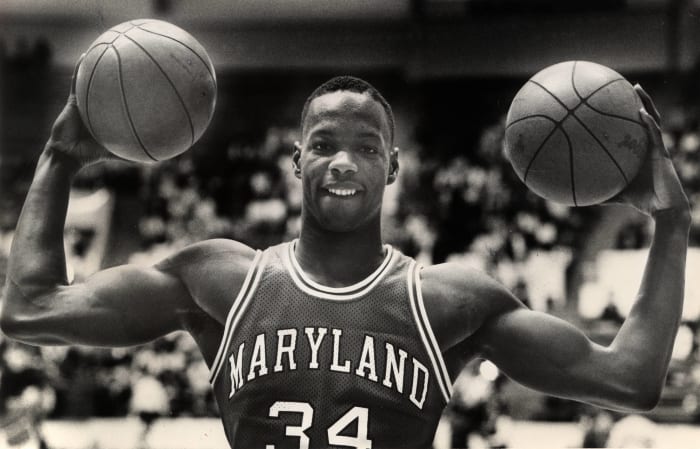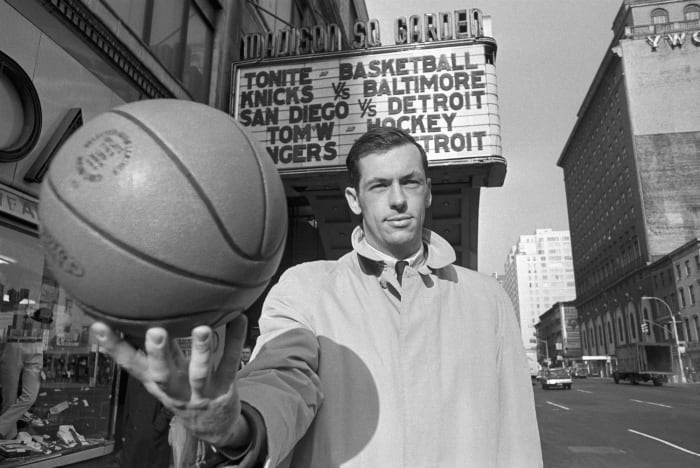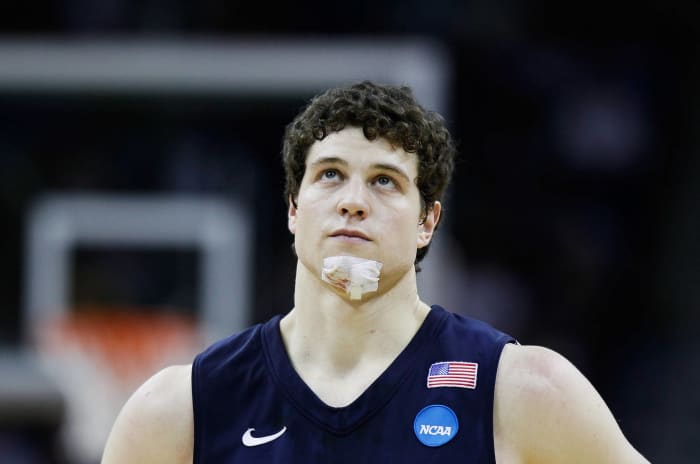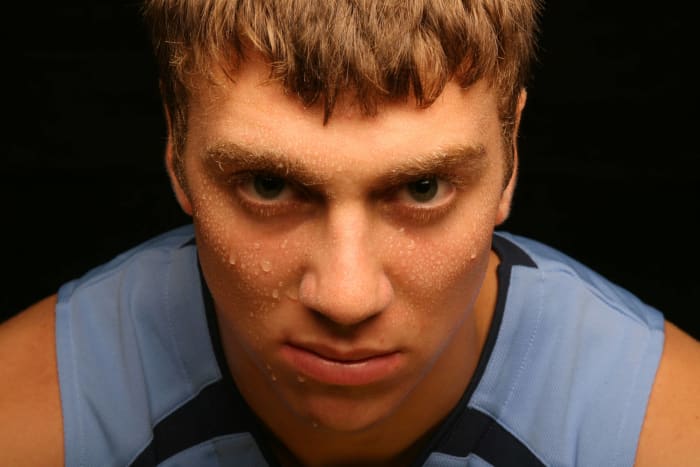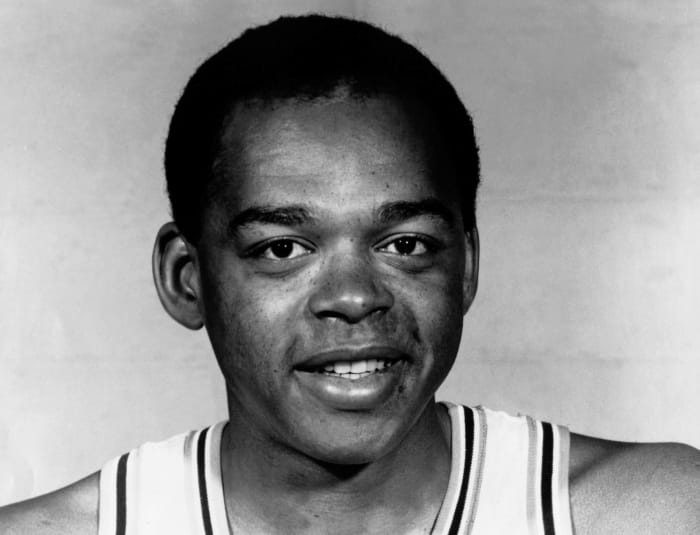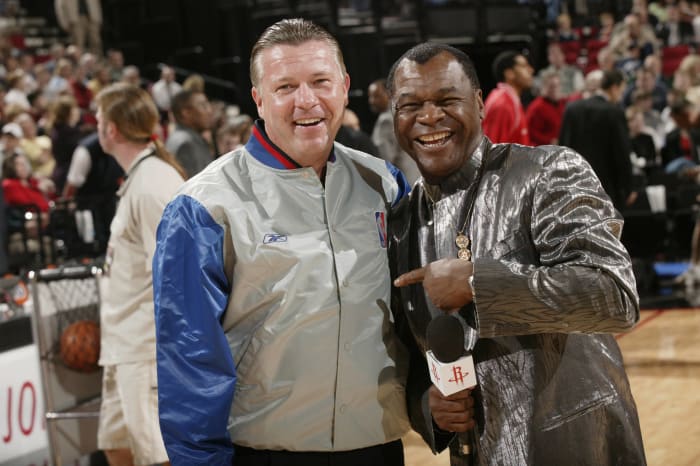College basketball has undergone many changes over the years. Whether it was outlawing dunks, ruling on freshman ineligibility, adding a three-point line, or adjusting the shot clock or one-and-done rules, college hoops has always faced new challenges and adjustments.
Of course, the constant has always been the turnover of talent. No matter how great you are, you eventually have to move on and make room for the new, young talent. Yet despite all the changes, there's always been great talent.
To fine-tune the list of all the great college basketball players in history down to the 50 greatest is a difficult task. Some players exploded onto the scene and then bolted for NBA riches, while others had a three- or four-year dominant career.
So enjoy the 50 greatest players in college basketball history.
1 of 50
Lew Alcindor, UCLA
Robert Abbott Sengstacke/Getty Images
Alcindor, who changed his name to Kareem Abdul-Jabbar when he got into the NBA, may have been the greatest talent to even set foot on a college court and may have had the greatest career of any player in college history. He averaged 26.4 points and 15.5 rebounds during his three years at UCLA. He won three national championships, won 88 of the 90 games he played and it was because of him that the NCAA outlawed dunking.
2 of 50
Rick Barry, Miami
Joe Murphy/NBAE/Getty Images
Barry is the only player to ever lead the NCAA, ABA and NBA in scoring for a season. In his senior season at Miami, Barry averaged 37.4 point per game and was a consensus first-team All-American plus had five games in which he scored at least 50 points. He averaged 29.8 points and 16.5 rebounds as a Hurricane.
3 of 50
Elgin Baylor, Seattle
Bettmann / Contributor / Getty Images
After one season at Idaho, Baylor transferred to Seattle and led the team to the 1958 national championship game, but it would lose to Kentucky. Baylor was so good that the Lakers drafted him in 1956 (Baylor opted to stay in school) and the 1958 draft. (Then he decided to leave college for the team.) In three college seasons, he averaged 31.3 points and led the nation in rebounding in 1957.
4 of 50
Walter Berry, St. John's
George Gojkovich/Getty Images
Berry was one of the greatest JUCO players ever, winning the National Player of the Year Award after averaging 28.9 points and 14 rebounds. He transferred to St. John's for his junior season where he would average 20.1 points and 9.9 rebounds during his Redmen career. He would win various Player of the Year honors...including the Wooden Award ..for his 1985-1986 season.
5 of 50
Len Bias, Maryland
Joel Richardson/The Washington Post/Getty Images
Bias was one of the best players in the nation during a time when the ACC was chock full of talent. (He played during the era that included Michael Jordan and Ralph Sampson.) Opponents tell stories about how dominant he was and how tough it was to guard him. He was a two-time ACC Player of the Year and led the conference in scoring his junior season. He died from cardiac arrhythmia due to a cocaine overdose two days after becoming the No. 2 overall pick in the 1986 NBA Draft.
6 of 50
Larry Bird, Indiana State
Bettmann / Contributor / Getty Images
Bird bolted Indiana University after one month and would eventually transfer to Indiana State. In his senior year, he led the Sycamores to an undefeated record heading into the NCAA Tournament before they suffered their first loss against Magic Johnson and Michigan State in the championship game. He won the 1979 Naismith Award and averaged 30.3 points per game for his college career.
7 of 50
Bill Bradley, Princeton
Bettmann / Contributor / Getty Images
Despite playing over 50 years ago, Bradley still owns several Ivy League records. He's the conference's all-time leading scorer and in free throws made and attempts, and he holds single-season records for all those categories. He scored 58 points in the consolation game in 1965 and was named the Most Outstanding Player that year.
8 of 50
Austin Carr, Notre Dame
Joe Robbins/Getty Images
Carr averaged 34.5 points per game for his career and was the 1971 National Player of the Year. He scored 61 points against Ohio in the 1970 NCAA Tournament, setting a tournament record. During his Irish career, he averaged 50 points per game over seven tournament appearances.
9 of 50
Wilt Chamberlain, Kansas
Bettmann / Contributor / Getty Images
In his first varsity game, Wilt scored 52 points and grabbed 31 rebounds — both Kansas records. He was a two-time, first-team All-American, the 1957 Final Four MVP, and he averaged 29.9 points and 18.3 points despite opposing teams' attempts to stall games to limit Chamberlain's effectiveness. He would leave Kansas after two seasons due to frustration over how teams were playing him.
10 of 50
Adrian Dantley, Notre Dame
Karl Gehring/The Denver Post via Getty Images
Dantley is second all time in scoring at Notre Dame and was a two-time All-American. He lived at the free-throw line, setting Irish records for free throws made and attempted. As a sophomore, he led the team with 30.4 points and 10.2 rebounds and was the leading scorer for the 1976 Olympic team.
11 of 50
Tim Duncan, Wake Forest
Brian Bahr / Getty Images
Duncan wasn't flashy, but he was effective. He used fundamentally sound post moves to score and was so solid a defensive player that he quickly became one of the best players in the nation. In an era when high school players started bypassing college for the NBA, Duncan stayed four years. He left college as the all-time leader in rebounds and the first player to score 1,500 points, 1,000 boards, 200 assists and 400 blocks.
12 of 50
Patrick Ewing, Georgetown
Mitchell Layton/BIG EAST Conference/Collegiate Images/Getty Images
Ewing was such a unique force for Georgetown in the 1980s. His Hoyas went to three national championship games in which they beat Akeem Olajuwon and the Houston Cougars and lost to Michael Jordan's North Carolina and a Villanova team that played the (near) perfect game. He was a three-time, first-team All-American.
13 of 50
Danny Ferry, Duke
Scott Cunningham/NBAE via Getty Images
Ferry was a do-everything forward who was a great scorer, rebounder and passer as well as a knock-down shooter as a big man. He led the Blue Devils to three Final Fours in his four seasons and is the only Duke player to be in the top 10 in career points, rebounds and assists. He won the 1989 Naismith Award.
14 of 50
Phil Ford, North Carolina
North Carolina/Collegiate Images/Getty Images
Ford was regarded as having the best career at North Carolina. As a sophomore, he was the starting point guard for the 1976 United States Olympic team. He was the all-time leading scorer in Tar Heels history until Tyler Hansbrough broke his record in 2009 and epitomized Dean Smith's "four corners" offense. He was a three-time All-American and the 1978 National Player of the Year.
15 of 50
Jimmer Fredette, BYU
Kevin C. Cox/Getty Images
As a senior, Fredette led the nation in scoring and was the 2011 National Player of the Year. That season, he averaged 28.9 points and set numerous BYU and Mountain West records. He left school as the Cougars all-time leading scorer.
16 of 50
Hank Gathers, Loyola Marymount
Tim de Frisco /Allsport / Getty Images
In 1989, Gathers became just the second player to lead the nation in both scoring and rebounding by averaging 32.7 points and 13.7 rebounds. Due to LMU's fast-paced offense and trapping defense, Gathers scored a lot of his points on layups, dunks and short jump shots. Gathers collapsed during a West Coast Conference Tournament game against Portland and died shortly after at a nearby hospital.
17 of 50
Tom Gola, La Salle
Bettmann / Contributor / Getty Images
Gola led the Explorers to the 1952 NIT Championship and to the 1954 NCAA Championship (They were runners-up for the 1955 NCAA Championship.) He was the 1954 national Player of the Year and is the NCAA's all-time leading rebounder with 2,201 boards.
18 of 50
Tyler Hansbrough, North Carolina
Bob Leverone/Sporting News via Getty Images
Hansbrough is the most decorated player in North Carolina history. He was the 2008 Player of the Year, won the 2009 national championship, finished his career as the ACC's all-time leading scorer and the Tar Heels' all-time leading rebounder, and he set the NCAA's record for made free throws. "Psycho T" was known for his intense nature and is beloved for winning all four of his trips to Cameron Indoor Stadium.
19 of 50
Elvin Hayes, Houston
Bettmann / Contributor / Getty Images
Hayes is best known for one college game: the "Game of the Century" against Lew Alcindor and UCLA. Hayes scored 39 points and won that first nationally televised regular-season college hoops game (the win snapped UCLA's 47-game winning streak). In that 1968 season, he averaged 36.8 points and was the AP Player of the Year. He averaged 31 points and 17.2 rebounds for his career.
20 of 50
Walt Hazzard, UCLA
NBA Photo Library/NBAE via Getty Images
Hazzard was the first (of many) stars who contributed to UCLA's dynasty of the 1960s and 1970s. He led the Bruins to their first Final Four back in 1962 and to their first championship in 1963. As a senior, he was named USBWA Player of the Year, and John Wooden once said "I never had a better man on the fast break than Walt Hazzard."
21 of 50
Grant Hill, Duke
Focus on Sport/Getty Images
In Hill's four seasons in Durham, he won two national championships and played in another tournament final (a loss to Arkansas). He won the national Defensive Player of the Year award and was an ACC Player of the Year. In 2018, he became the first Duke player to be elected to the Basketball Hall of Fame.
22 of 50
Allen Iverson, Georgetown
Getty Images
Iverson played just two seasons at Georgetown, but he was one of the best and most exciting players in the country. He averaged 23.0 points and 4.6 assists and was one of the most popular players. He holds the Hoyas' record for career scoring average and became the No. 1 overall pick in the 1996 NBA Draft.
23 of 50
Magic Johnson, Michigan State
Bettmann / Contributor / Getty Images
Magic averaged 17.1 points, 7.6 rebounds and 7.9 assists during his two seasons in East Lansing. After reaching the Elite Eight in his freshman season, Magic led the Spartans to the 1979 NCAA Championship by beating Larry Bird and Indiana State in the most-watched college basketball game in history.
24 of 50
Michael Jordan, North Carolina
Focus on Sport/Getty Images
Jordan averaged 17.7 points at North Carolina, famously starting the joke that the only person who could hold Jordan below 20 points per game was Dean Smith. As a freshman, he hit the game-winning shot in the 1982 national championship game. As a sophomore and junior, he was a consensus All-American and was the 1984 Wooden and Naismith Awards winner.
25 of 50
Bernard King, Tennessee
Bettmann / Contributor / Getty Images
Brooklyn native King took his talents to Tennessee where he was SEC Player of the Year three times and averaged 25.8 points per game. He led the SEC in rebounding twice and is the Vols' second-leading scorer all time.
26 of 50
Christian Laettner, Duke
Focus on Sport/Getty Images
Possibly the most-hated college basketball player ever...but he was really good. He led the Blue Devils to four consecutive Final Fours (Laettner played in 23 of a possibly 24 NCAA Tournament games in his career) and won back-to-back titles in 1991 and 1992. His shot to beat Kentucky in the 1992 Regional Finals may be the most memorable in the history of college basketball.
27 of 50
Jerry Lucas, Ohio State
NBA Photo Library/NBAE/Getty Images
All three of Lucas' seasons at Ohio State ended in the NCAA Tournament final with the Buckeyes winning the championship in 1960 and losing to Cincinnati in 1961 and 1962. He averaged 24.3 points and 17.2 rebounds for his career and was the first basketball player to be Sports Illustrated Sportsman of the Year, in 1961.
28 of 50
Danny Manning, Kansas
Bettmann / Contributor / Getty Images
Manning's Kansas career is known most for his "Danny and the Miracles" team winning the 1988 national championship. He was the winner of the Wooden and Naismith in 1988 and is the Jayhawks' all-time leading scorer. He was later named the Big Eight's Player of the Decade.
29 of 50
Pete Maravich, LSU
Martin Mills/Getty Images
"Pistol Pete" Maravich is the all-time leading scorer in NCAA history. He scored 3,667 points and averaged 44.2 points during his career with the Tigers. He did all of that despite playing when freshmen were ineligible, there was no three-point line and there was no shot clock. Another crazy fact about Pistol Pete? He never played in the NCAA Tournament.
30 of 50
Scott May, Indiana
Bettmann / Contributor / Getty Images
May is known more as the best player on the last team to finish the season undefeated. In his junior and senior seasons, May's Hoosiers finished with a total of just one loss. As a senior, he averaged 23.5 points and 7.7 rebounds and was the AP Player of the Year.
31 of 50
Xavier McDaniel, Wichita State
Rick Stewart/Getty Images
McDaniel was the first person to ever lead the NCAA in both scoring (27.4) and rebounding (15). He averaged 22.2 points and 14.1 rebounds over the final three years of his college career and was twice named the Missouri Valley Conference Player of the Year.
32 of 50
Rick Mount, Purdue
Michael Hickey/Getty Images
The first game that Mount played at Purdue, he scored 28 points in a two-point loss to Lew Alcindor's UCLA Bruins. He averaged 28.4 points in that sophomore season and would average 32.3 points for his career. Because he played during Alcindor and Maravich's era, he didn't win any Player of the Year Awards but was a three-time All American.
33 of 50
Calvin Murphy, Niagara
Sam Forencich/NBAE via Getty Images
Murphy averaged 33.1 points per game for his Purple Eagles career, but he really shined right out of the gate. He averaged 48.9 points for the freshman team before scoring 38.2 points as a sophomore for the varsity squad. Murphy, along with Rick Mount and Pete Maravich, formed the "Three Ms."
34 of 50
Shaquille O'Neal, LSU
Chris Graythen/Getty Images
Shaq was a dominant force in college, especially starting with his sophomore season. For his Tigers career, he averaged 21.6 points, 13.5 rebounds and 4.6 blocks while shooting 61 percent from the field despite being double- or triple-teamed constantly. He was the SEC's Player of the Year twice.
35 of 50
Bob Pettit, Purdue
Bruce Yeung/NBAE via Getty Images
Pettit was a two-time All-American and a three-time All-SEC selection at LSU. He averaged 27.8 points per game over three seasons with the Tigers, and as a senior he averaged 31.4 points and 17.3 rebounds per game.
Kevin C. Cox/WireImage/Getty Images
The 2006 national Player of the Year had a magnificent career at Duke, even if it didn't end with a championship. He was a stone-cold shooter who would go into a shooting zone where he would hit ridiculously long threes. He also was a 91 percent free-throw shooter and may have received more vitriol from opposing fans than anyone in college hoops.
37 of 50
Glen Rice, Michigan
Getty Images / Staff
Rice is Michigan's all-time leading scorer in both career points and in a single season. In the 1988-1989 season, he shot 51.6 percent from three as the Wolverines won the national championship. Rice averaged 25.6 points as a senior during that championship season.
38 of 50
Oscar Robertson, Cincinnati
Cincinnati/Collegiate Images/Getty Images
Robertson's Bearcats went 79-9 during his three seasons in Cincinnati yet didn't win a national championship. (Cincinnati would win consecutive titles after he graduated.) He left college as its all-time leading scorer, averaging 33.8 points and 15.2 rebounds for his career. He would record 10 triple-doubles in college.
39 of 50
David Robinson, Navy
Greg Fiume/NBAE via Getty Images
You know you are a really good player when an NBA team is willing to draft you No. 1 overall and wait two more years to have you as you finish your military commitment. He won both the Naismith and Wooden Awards in 1989 and was a two-time All-American. As a junior, he averaged 5.9 blocks per game and averaged 28.2 points as a senior.
40 of 50
Glenn Robinson, Purdue
Doug Pensinger /Allsport /Getty Images
"Big Dog" was the 1994 national Player of the Year as he led the nation in scoring with 30.3 points and 11.2 rebounds. He wasn't just a premier scorer, though. He also made hustle plays and was an outstanding rebounder, earning the No. 1 overall pick in the 1994 NBA Draft. He was the first Boilermaker to be a national player of the year since John Wooden.
41 of 50
Bill Russell, San Francisco
Bettmann / Contributor / Getty Images
Russell was a perfect fit for San Francisco's philosophy of tough defense and fundamentally sound offense. The Dons would once win 55 straight games and would win the 1955 and 1956 NCAA championships. He'd average 20.7 points and 20.3 rebounds and was one of the reasons the NCAA made changes regarding the free-throw lane and rules on basket interference.
42 of 50
Ralph Sampson, Virginia
Ronald C. Modra/ Getty Images
Sampson won the Naismith Award three straight years (Bill Walton is the only other player to accomplish that) and was the No. 1 overall pick in the 1983 NBA Draft. The 7-foot-4 phenom took the Cavaliers to the 1981 Final Four and the 1980 NIT Championship. He averaged 16.9 points and 11.4 rebounds per game for his college career.
43 of 50
Frank Selvy, Furman
NBA Photo Library/NBAE via Getty Images
Selvy had an outstanding career at Furman and is one of only three players to average 40 points per game for his college career. He is best known for scoring 100 points in a game against Newberry in 1954 on what was "Frank Selvy Night."
44 of 50
Lionel Simmons, La Salle
Getty Images
Simmons tends to be forgotten due to La Salle not being a major college program, but he had one of the best careers most didn't get to see. He scored 3,217 points and grabbed 1,429 rebounds during his Explorers career, becoming the only player in the 3,000-point/1,000 rebound club. He was the Metro Conference Player of the Year three times and won the Wooden and Naismith Awards in 1990.
45 of 50
David Thompson, NC State
Ethan Hyman/Raleigh News & Observer/MCT via Getty Images
Most people remember David Thompson as the guy who lost the ABA dunk contest to Dr. J. But Thompson really was the Michael Jordan of the 1970s. He led NC State to a 27-0 record in 1973, but the team was banned from the NCAA Tournament due to recruiting violations. The following season, the 30-1 Wolfpack ended UCLA's seven-year reign as national champions by beating the Bruins in the Final Four and going on to win the title. Thompson would average 29.9 points per game his senior season.
46 of 50
Wayman Tisdale, Oklahoma
Layne Murdoch/NBAE via Getty Images
Tisdale was a three-time All-American at Oklahoma and a three-time Big Eight Player of the Year. He averaged 25.6 points and 10.1 rebounds in his three seasons in Norman and was the No. 2 overall pick in 1985.
47 of 50
Wes Unseld, Louisville
Bettmann / Contributor / Getty Images
Unseld averaged 35.8 points on Louisville's freshman team before going on to a great Cardinals career on the varsity team. He led the Missouri Valley Conference in rebounding for three seasons and was a two-time All American. He averaged 20.6 points and 18.9 rebounds for the Cardinals.
48 of 50
Bill Walton, UCLA
Streeter Lecka/Getty Images
The Bruins had consecutive 30-0 seasons with Walton as the star and much of UCLA's record 88-game winning streak. He won the Naismith Award three years in a row (only Ralph Sampson has matched that feat), and his effort in the 1973 national championship game against Memphis State (44 points on 21-of-22 shooting) may be the best individual performance in NCAA Tournament history.
49 of 50
Jerry West, West Virginia
Allen Berezovsky/Getty Images
West was a dominant scorer and rebounder and had one of the best shots in college history. He averaged 24.8 points and 13.3 rebounds and was the Southern Conference's Player of the Year twice. He was the Final Four's Most Outstanding Player in 1959 despite not winning the championship (mirroring his NBA Finals MVP award and not winning the championship).
50 of 50
Freeman Williams, Portland State
Dick Raphael/NBAE via Getty Images
Williams led the nation in scoring in 1977 and 1978 and trails only Pete Maravich in career scoring. Interesting fact: He played the role of Duck Johnson in "White Men Can't Jump."
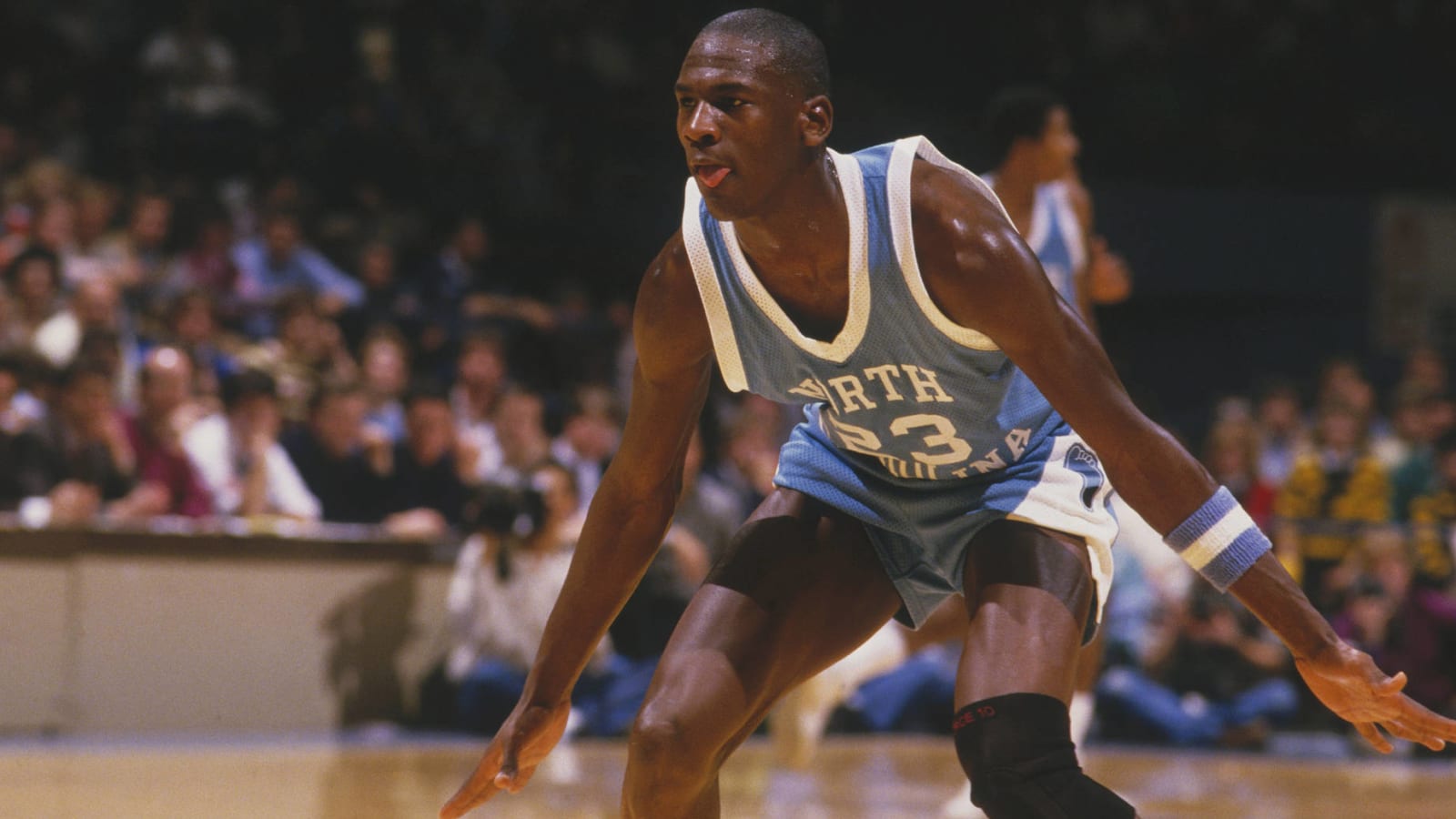
 +
+
